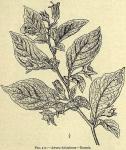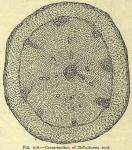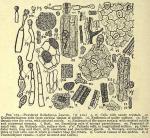 The dried root and the dried leaves official.
The dried root and the dried leaves official.
BOTANICAL CHARACTERISTICS.—At'ropa Belladon'na Linné. Root perennial, fleshy, white within; stem 3 to 5 feet high, with a tinge of red. Leaves short-petiolate, ovate, acute, entire, more or less hirsute. Flowers solitary, drooping; calyx campanulate; corolla campanulate, twice the length of the calyx, greenish at the base, varying to dark purple at the border. Berry 9-lobed, violet-black; seeds uniform.
503. Belladonnae Radix
The dried root of Atropa Belladonna Linné, yielding, when assayed by U.S.P. process, not less than 0.45 per cent. of its alkaloids.
 DESCRIPTION OF DRUG.—Rough, irregular, longitudinally wrinkled, somewhat tapering pieces, from 12 to 25 mm. (½ to 1 in.) thick, of a dirty-gray color externally, internally whitish; fracture short, mealy when dry, tough when damp; odor narcotic; taste slightly sweetish, afterward bitter and acrid. Tough, woody roots, breaking with a splintery fracture, should be rejected, also the hollow stem-bases sometimes present.
DESCRIPTION OF DRUG.—Rough, irregular, longitudinally wrinkled, somewhat tapering pieces, from 12 to 25 mm. (½ to 1 in.) thick, of a dirty-gray color externally, internally whitish; fracture short, mealy when dry, tough when damp; odor narcotic; taste slightly sweetish, afterward bitter and acrid. Tough, woody roots, breaking with a splintery fracture, should be rejected, also the hollow stem-bases sometimes present.
STRUCTURE.—The bark is rather thick, free from bast fibers, composed almost entirely of parenchymatous tissue containing starch-grains and calcium oxalate raphides; directly underneath the periderm is a darker line composed of six to eight tabular cells. In the center of the root is a small pith, surrounded in the younger root by distant wood-fibers scattered throughout the parenchymatous tissue; in older roots the wood-bundles are more numerous, and traversed by broad medullary rays.
Belladonna is sometimes mistaken for, or adulterated with, althaea, from which it may be distinguished by the smoothness of its outer layer (althaea has projecting fibers), by its fracture, which does not show protruding fiber-ends, and by the wood-bundles, which are readily discernible in the former, but not in the latter.
ADULTERATIONS.—Certain species of Mandragora yield very nearly allied roots both in external appearance and structure, but they are not likely to be confounded with belladonna roots.
The rhizomes of Scopola carniolica are very similar to the root of belladonna; the bark, however, of the former, is less thick, starch-grains smaller, and shape less distinct. Scopola Japonica (Japanese belladonna) is found to be similar to S. carniolica.
 Powder.—Microscopical elements of: See Part iv, Chap. I, B.
Powder.—Microscopical elements of: See Part iv, Chap. I, B.
CONSTITUENTS.—The active principles are alkaloids, the chief of which are atropine, hyoscyamine and hyoscine. Atropine is a compound of equal amounts of the isomers, dextro- and levo-hyoscyamine into which it separates and is readily changed to dextro-hyoscyamine. In the growing belladonna the hyoscyamine is said to form in the young leaves, to be later changed to atropine.
According to the predominance of one or other of these alkaloids, and to the amounts present, the drugs of this group fall into a regular pharmacologic series, as follows:
- Belladonna (root and leaves), the leaves containing 0.35 per cent., and the root, 0.5 per cent., of alkaloid, which is nearly all atropine. It has, therefore, a typical atropine action.
- Scopola (root) contains 0.5 per cent. of alkaloid, about equally hyoscyamine and atropine. It acts like belladonna, but with somewhat less strength.
- Stramonium (leaves) contains 0.35 per cent. of alkaloid, mostly hyoscyamine but with small amounts of atropine and hyoscyine. It is less stimulating to the cerebrum and may be narcotic.
- Hyoscyamus (leaves) contain 0.08 per cent. of alkaloid, mostly hyoscyamine, with a fair amount of hyoscine, and only traces of atropine. It is rather narcotic but is weaker than the other drugs of the group (Bastido),
Ash, root, not more than 7 per cent.; leaves, not more than 20 per cent.
ACTION AND USES.—Applied externally belladonna is anodyne and anesthetic. Internally the activity of the peripheral terminations of all the secretory nerves in the body is depressed. Dropped into the eye, solutions of belladonna or atropine quickly dilate the pupil and accommodation is paralyzed. Upon the heart it has a stimulating action- toxic doses abolish the function of the cardiac muscles and the heart stops in diastole, When a 1 per cent. solution of atropine sulphate is dropped into the eye, the pupil dilates in about fifteen or twenty minutes, but takes two hours to reach the maximum dilation. The pupil gradually regains its power but is not fully restored to normal for one or two weeks.
An antagonist of atropine is physostigmine, which stimulates the ends of the third nerve. It is not powerful enough to remove the effects of atropine at once, but greatly lessens the time which the eye takes to return to normal.
Dilated pupils, dry throat, and wild cerebral symptoms are the regular warnings of overdosage. In full poisoning there is a stage of central stimulation followed by collapse. Dose: 1 to 3 gr. (0.065 to 0.2 Gm.); of atropine, 1/64 to 1/100 gr. According to Cushney, hyoscyamine is twice as active as atropine in checking secretions and in pupil dilatation.
- OFFICIAL PREPARATIONS.
- Fluidextractum Belladonnae Radicis, Dose: 1 to 3 drops (0.065 to 0.2 Mil).
- Linimentum Belladonnae (95 per cent., with camphor 5 per cent.).
504. Belladonnae Folia
The dried leaves of Atropa Belladonna, yielding not less than 0.3 per cent. of total alkaloids.
DESCRIPTION OF DRUG.—As they come into market, these leaves are crumpled and broken, of a dull brownish-green tint, the under surface paler than the upper, and with a prominent woody midrib prolonged below into a petiole, margin entire; one of the characteristics is the small, circular holes puncturing the leaves by the dropping off of corky excrescences. This, however, applies, but in a less degree, to the other narcotic leaves. It should be observed that the margins of the three narcotic leaves, belladonna, stramonium, and hyoscyamus, are quite different.
Powder.—Microscopical elements of: See Part iv, Chap. I, B.
CONSTITUENTS.—The alkaloids hyoscyamine and atropine (0.3 to 0.7 per cent.) are present. Belladonnine (oxyatropine) and other alkaloids of less importance exist, with chrysatropic acid. Ash, not exceeding 20 per cent.
ACTION AND USES.—Same as the root. Dose: 1 gr. (0.065 Gm.). The extract is employed in: Pil. Laxative Co. and Pil. Podophyl., Bellad. et Capsici, and in the following:
- OFFICIAL PREPARATIONS.
- Tinctura Belladonnae Foliorum (10 per cent.) Dose: 5 to 15 drops (0.3 to 1 mil).
- Extractum Belladonnae Foliorum (1-4 per cent, alkaloid) ⅛ to ¾ gr. (0.008 to 0.048 Gm.).
- Unguentum Belladonnae (1 0 percent.).

